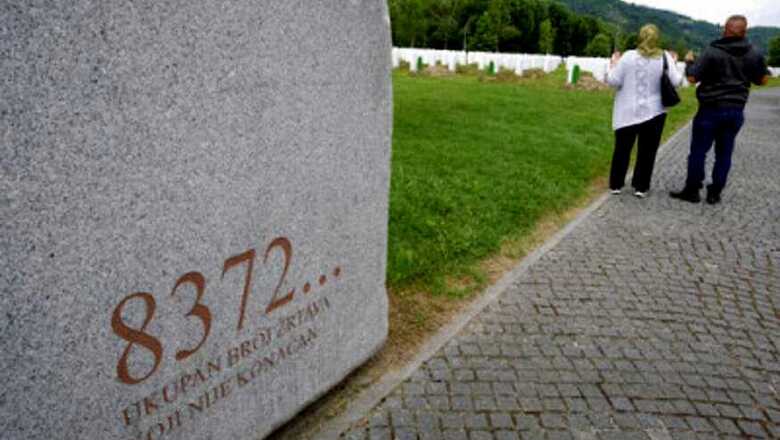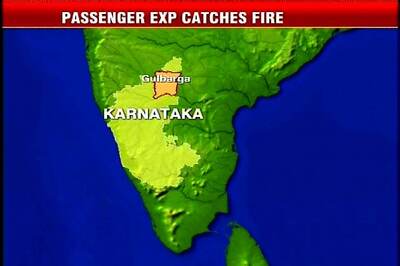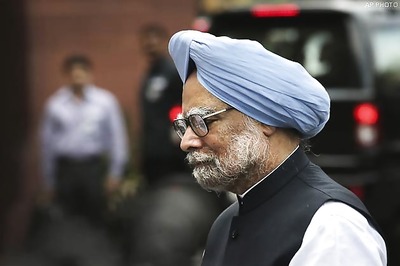
views
Twenty-five years ago, more than 8,000 Muslim men and boys were massacred at Srebrenica by Bosnian Serb troops, in one of the darkest chapters of the break up of Yugoslavia.
The worst massacre in Europe since World War II, it was classed as genocide by the International Criminal Tribunal for the former Yugoslavia (ICTY).
It marked a turning point in the war in Bosnia, the most ethnically-mixed of Yugoslavia's six republics. Muslims, Serbs and Croats battled each other from 1992 to 1995, leaving nearly 100,000 people dead and 2.2 million others displaced.
Five things to know about the massacre:
Enclave falls
Besieged by Bosnian Serb forces from the beginning of the conflict, the eastern mainly-Muslim town of 148 square kilometres (57 square miles) was declared a "safe area" by the UN in April 1993. UN peacekeepers were deployed.
On the morning of July 11, 1995, the Bosnian Serb army of Ratko Mladic finally overran Srebrenica, however, causing tens of thousands of refugees to flee to the Dutch UN peacekeeping force's compound at Potocari on the hilly town's northern outskirts.
The peacekeepers and about 5,000 refugees, mostly women and children, retreated into the UN base, while thousands of others gathered outside.
The refugees inside the base were eventually expelled into the hands of waiting Bosnian Serb troops, who started forcibly bussing people out, separating the men and boys from the women.
Massacre
In the following days more than 8,000 Muslim men and boys were systematically butchered by the Bosnian Serb forces under Mladic's command and their bodies dumped in mass graves.
Hundreds of men who fled into the surrounding forests were rounded up and shot.
Most of the mass graves were later dug up with bulldozers and the bodies removed to hide the scale of the crime.
Witness accounts quickly emerged, collected by aid organisations from escapees who recounted the atrocities of Mladic's men.
Genocide convictions
A total of 51 convictions have been made, 20 for genocide, by international courts and those in Bosnia and Serbia.
The highest-ranking Bosnian Serb political leader, Radovan Karadzic, was sentenced to life in prison on appeal in March 2019. Karadzic is behind bars at the UN's high-security detention unit in The Hague.
Nicknamed the "Butcher of Bosnia", Mladic was sentenced to life in prison in November 2017. Judges said he "intended to eliminate Bosnian Muslims by killing men and boys."
Mladic is appealing the charges and has urged judges to acquit him. He is still behind bars at the UN's detention unit in The Hague, awaiting the decision of the tribunal which replaced the ICTY.
International community blamed
The international community has been regularly accused of having abandoned the Srebrenica victims, especially by not ordering airstrikes.
Sarajevo, Bosnia and Herzegovina | AFP | Thursday 7/9/2020 - 07:41 UTC+5 | 606 words
Twenty-five years ago, more than 8,000 Muslim men and boys were massacred at Srebrenica by Bosnian Serb troops, in one of the darkest chapters of the break up of Yugoslavia.
The worst massacre in Europe since World War II, it was classed as genocide by the International Criminal Tribunal for the former Yugoslavia (ICTY).
It marked a turning point in the war in Bosnia, the most ethnically-mixed of Yugoslavia's six republics. Muslims, Serbs and Croats battled each other from 1992 to 1995, leaving nearly 100,000 people dead and 2.2 million others displaced.
Five things to know about the massacre:
- Enclave falls -
Besieged by Bosnian Serb forces from the beginning of the conflict, the eastern mainly-Muslim town of 148 square kilometres (57 square miles) was declared a "safe area" by the UN in April 1993. UN peacekeepers were deployed.
On the morning of July 11, 1995, the Bosnian Serb army of Ratko Mladic finally overran Srebrenica, however, causing tens of thousands of refugees to flee to the Dutch UN peacekeeping force's compound at Potocari on the hilly town's northern outskirts.
The peacekeepers and about 5,000 refugees, mostly women and children, retreated into the UN base, while thousands of others gathered outside.
The refugees inside the base were eventually expelled into the hands of waiting Bosnian Serb troops, who started forcibly bussing people out, separating the men and boys from the women.
- Massacre -
In the following days more than 8,000 Muslim men and boys were systematically butchered by the Bosnian Serb forces under Mladic's command and their bodies dumped in mass graves.
Hundreds of men who fled into the surrounding forests were rounded up and shot.
Most of the mass graves were later dug up with bulldozers and the bodies removed to hide the scale of the crime.
Witness accounts quickly emerged, collected by aid organisations from escapees who recounted the atrocities of Mladic's men.
- Genocide convictions -
A total of 51 convictions have been made, 20 for genocide, by international courts and those in Bosnia and Serbia.
The highest-ranking Bosnian Serb political leader, Radovan Karadzic, was sentenced to life in prison on appeal in March 2019. Karadzic is behind bars at the UN's high-security detention unit in The Hague.
Nicknamed the "Butcher of Bosnia", Mladic was sentenced to life in prison in November 2017. Judges said he "intended to eliminate Bosnian Muslims by killing men and boys."
Mladic is appealing the charges and has urged judges to acquit him. He is still behind bars at the UN's detention unit in The Hague, awaiting the decision of the tribunal which replaced the ICTY.
- International community blamed -
The international community has been regularly accused of having abandoned the Srebrenica victims, especially by not ordering airstrikes.
In a 2000 report, UN Secretary-General Kofi Annan blamed the whole of the international community for its failure to protect Srebrenica.
Open wound in the Netherlands
The role of the Dutch peacekeepers, regularly criticised for having not protecting the refugees, remains a sensitive subject in the Netherlands, where former soldiers say they have been scarred for life.
In 2002, the Dutch government resigned after the publication of a report which said it might hold some responsibility for the massacre.
Several cases have gone to court, including one successfully brought against the government by the "Mothers of Srebrenica" concerning some 350 Bosnian men expelled from the Dutch base.
However, in 2019 the Netherlands Supreme Court reduced the level of the Dutch state's liability for the deaths of these men from 30 percent to 10 percent, saying there was only a "slim" chance of saving them.

















Comments
0 comment